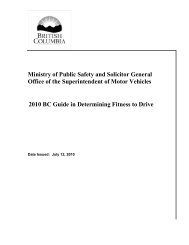Community Accountability Programs Information ... - Ministry of Justice
Community Accountability Programs Information ... - Ministry of Justice
Community Accountability Programs Information ... - Ministry of Justice
- No tags were found...
Create successful ePaper yourself
Turn your PDF publications into a flip-book with our unique Google optimized e-Paper software.
committed, they then decide how to address the actions <strong>of</strong> the alleged<strong>of</strong>fender.If the police believe that an incident warrants charges or authorizedalternative measures, they complete a Report to Crown Counsel (RCC) andsend it to the local Crown counsel. In some cases, however, the police mayexercise their discretion and deal with the situation in a way that does notinvolve Crown counsel and the courts. In effect, the police “divert” theperson away from the criminal justice system, choosing to handle the casethrough a process <strong>of</strong> informal resolution rather than proceeding withcharges.Informal resolution is used for less serious (Category 3 and 4) criminal<strong>of</strong>fences. (See Appendix A.) This approach includes actions such as:• Giving the <strong>of</strong>fender an informal warning• Sending a formal caution letter to the <strong>of</strong>fender. In the case <strong>of</strong> young<strong>of</strong>fenders, the letter is also sent to their parents.• Referring the <strong>of</strong>fender to a social, health, educational, or other agency• Facilitating an informal resolution between the victim and the <strong>of</strong>fender• Referring the case to a <strong>Community</strong> <strong>Accountability</strong> ProgramFor cases involving youth, the Youth Criminal <strong>Justice</strong> Act contains manyprovisions that encourage the appropriate use <strong>of</strong> extrajudicial measures todeal with less serious <strong>of</strong>fences. For example, under Sections 4 and 6 <strong>of</strong>the Act:• Police <strong>of</strong>ficers are required to consider using extrajudicial measuresbefore deciding to lay charges against a young person (s. 6).• Extrajudicial measures are presumed to be adequate for first-time, nonviolentyoung <strong>of</strong>fenders (s. 4).• Extrajudicial measures may be used even if the young <strong>of</strong>fender has aprevious record or has been dealt with previously through a restorativejustice process (s. 4).When an <strong>of</strong>fence is dealt with through informal resolution, n<strong>of</strong>ormal charges are laid. If the <strong>of</strong>fender does not comply with theterms <strong>of</strong> the informal resolution process, the Crown has no legalauthority to prosecute the original <strong>of</strong>fence.Guidelines for Working with Victims and Offenders 25
















